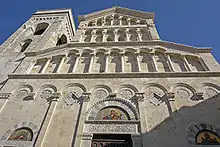| Cathedral of Our Lady of the Snows | |
|---|---|
 The cathedral and its square | |
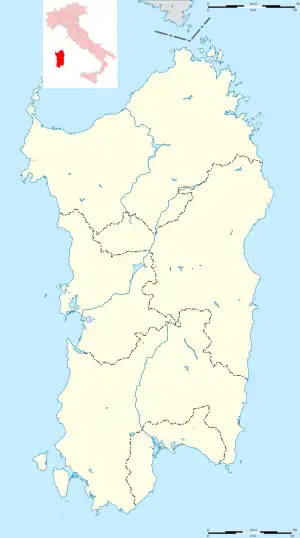 Cathedral of Our Lady of the Snows Location within Italy | |
| 40°19′14″N 09°20′12″E / 40.32056°N 9.33667°E | |
| Location | Nuoro, Sardinia |
| Country | Italy |
| Denomination | Roman Catholic |
| History | |
| Status | Cathedral of the Roman Catholic Diocese of Nuoro |
| Consecrated | 3 July 1873 |
| Architecture | |
| Previous cathedrals | one |
| Architect(s) | Antonio Cano |
| Style | Neoclassical |
| Years built | 1836–1873 |
| Groundbreaking | 12 November 1836 |
| Specifications | |
| Number of towers | two |
| Administration | |
| Archdiocese | Cagliari |
| Diocese | Galtelli-Nuoro (1779–1928) Nuoro (since 1928) |
| Clergy | |
| Archbishop | Giuseppe Baturi |
| Bishop(s) | Mosè Marcia |
The Cathedral of Our Lady of the Snows (Italian: Cattedrale di Santa Maria della Neve) is the main place of Roman Catholic worship in Nuoro, Sardinia, and the cathedral church of the diocese of Nuoro.
Built in the mid-nineteenth century, it stands in a square called the Piazza Santa Maria della Neve and is dedicated to the Madonna of the Snow (in Italian: Madonna della Neve; also, Our Lady of the Snows, Nostra Signora della Neve), the patron saint of Nuoro, whose cult is closely linked to the Santa Maria Maggiore basilica in Rome.
History
In 1779, with a papal bull called Eam inter Cœteras, Pope Pius VI reconstituted the ancient diocese of Galtellì, which had been abolished by Pope Alexander VI in 1496. However, the former seat of Galtelli was small and was not judged suitable as the home of an episcopal see, and the choice of a new seat fell on Nuoro. This had already for centuries been the seat of the pievania, first at an ancient church of St Aemilian, and later at the church of Santa Maria ad Nives, dating at least from the first half of the sixteenth century. In re-establishing the diocese, Pius VI chose that church as its cathedral.[1]
In 1828, the Bishop of Galtelli-Nuoro, Antonio Maria Casabianca, was put under an interdict, and soon afterwards Giovanni Maria Bua, Archbishop of Oristano, was appointed as apostolic administrator of the diocese.[2]
Buo judged the ancient church to be too small to serve as a permanent cathedral and ordered it to be pulled down, to make way for a new one.[3] He entrusted the work of designing this to a Franciscan, Frà Antonio Cano (1779–1840), who had studied architecture in Rome[4] and who had already worked on demolishing and rebuilding churches in Oristano.[5] Cano was a sculptor and a lay friar of the Order of Friars Minor Conventual.[6]
The foundation stone was laid on 12 November 1836, shortly after Charles Albert of Sardinia had declared Nuoro to be a city.[7] The budget for the building work was 34,000 Sardinian Lire, and an English commentator noted that the new church seemed far too large, as Nuoro already had eight other churches.[8]
In 1840, Cano fell from scaffolding at the cathedral[9] and died within hours.[6] By chance, Buo also died in the same year.[3] The building works were held up by these setbacks, and also by a lack of funds,[8] but the building was largely complete by 1853. The new cathedral was consecrated on 3 July 1873 by the bishop of the diocese, Salvatore Angelo Demartis,[10] and by Bishop Francesco Zunnui Casula.[3]
Architecture
The cathedral is in the neoclassical style and overlooks a large square in the historic centre of Nuoro. The West front recalls a classical temple, with four half-columns of granite which have Ionic capitals and support a triangular tympanum. This is framed by two identical bell towers, with a small dome above each of them.[11] The walls are built of granite and rubble, rendered over with cement.[8]
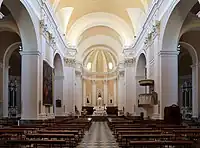
The interior has a large barrel-vaulted nave, and all around this is an entablature supported by pilasters which have Corinthian capitals. There are three chapels on each side of the nave, connecting with each other and each having a semicircular apse; the large spaces between them give the effect of side aisles. The chancel is raised a few steps above the nave and was at first enclosed by a marble baluster, which was taken out after the restoration work done between 2000 and 2006. At the east end of the cathedral is a semicircular apse, furnished with wooden choir stalls.[11]
In the first chapel on the right of the nave is the baptismal font and a statue of St John the Baptist, elements re-used from the previous church. In the vaulting of this chapel, traces survive of a fresco made by Antonio Carboni, partly hidden by later plaster dating from the early 20th century. In the last chapel on the left, which is dedicated to the Sacred Heart, is the cabinet of the Eucharist.[12]
Paintings
Inside the chancel is a painting of the fallen Christ being mourned by angels, long attributed to Alessandro Tiarini, but eventually this attribution was rejected, and the work is now reported as by an unknown early nineteenth-century neoclassical painter.[13] The rest of the paintings belong to the Sardinian school of the 19th and 20th centuries.[11]
Festival of the Redeemer

The festival of the Redeemer began at Nuoro in 1901, when a bronze statue of Christ the Redeemer was erected on top of Monte Ortobene at the initiative of Pope Leo XIII, who had wished to celebrate the new century with nineteen statues of the Redeemer in nineteen regions. Made on the mainland, the statue arrived by ship in Cagliari on 15 August 1901, in pieces. These arrived in Nuoro on 19 August and on the 29th were transported to the mountain-top by six ox-drawn carts. Re-assembled, the statue was more than four meters high and weighed more than twenty quintals. Bishop Salvatore Demartis organized the inauguration of the statue and invited the whole of Sardinia.[14]
On 29 August of each year since then, the Cathedral's congregation has made a pilgrimage to the statue of the Redeemer on top of Ortobene. A solemn mass is celebrated which concludes the local festival. There is a parade of traditional costumes, with singing and dancing, in which all the villages of Sardinia take part, and this is one of the best chances to see the traditional costumes of the island.[14][15]
Gallery
.jpg.webp) The fallen Christ mourned by angels, c. 1810
The fallen Christ mourned by angels, c. 1810 Dream of St John, 1935
Dream of St John, 1935 The Immaculate Conception
The Immaculate Conception The Annunciation
The Annunciation Fresco of the Assumption
Fresco of the Assumption_-_Sardinia%252C_Italy_-_25_Aug._2008.jpg.webp) View across the piazza
View across the piazza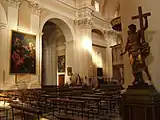 Looking across the nave
Looking across the nave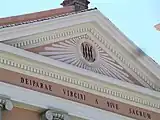 The tympanum
The tympanum
Notes
- ↑ Fernand Hayward, Jean Imbert, Sardaigne terre de lumiere (1956), p. 117 (in French): "En 1779, Pie VI érigeait la collégiale de Nuoro en cathédréale et créait ainsi le diocèse de Galtelli-Nuoro."
- ↑ Giuseppe Zichi, I cattolici sardi e il Risorgimento (2015), p. 100 Archived 2023-01-08 at the Wayback Machine
- 1 2 3 Ireneo Bellotta, I santi patroni d'Italia (Rome: Newton Compton, 1988), p. 198 (in Italian)
- ↑ Giuseppe Dessì, Scoperta della Sardegna: antologia di testi di autori italiani e stranieri (Milan: Edizioni Il Polifilo, 1965), p. 320 (in Italian): "Quest'architetto era un monaco francescano per nome frà Antonio Cano, il quale credeva d'aver studiato in Roma l'architettura ... È monsignor Giovanni Maria Bua che fu archivescovo di Oristano dal 1828 al 1840 e amministratore apostolico di Galtellì-Nuoro…"
- ↑ Alberto Ferrero della Marmora, Itinéraire de l'ile de Sardaigne: pour faire suite au Voyage en cette contrée, Volume 2, Volume 149 (Frères Bocca, 1860), pp. 162–163 Archived 2023-01-07 at the Wayback Machine (in French)
- 1 2 Pietro Meloni-Satta, Effemeride Sarda: Col l'aggiunta d'alcuni cenni biografici (1877), p. 170: "Lo scultore Antonio Lo scultore Antonio Cano, frate laico dei Minori Conventuali, cade da un pontaggio della Cattedrale di Nuoro, in costruzione, e dopo alcune ore cessa di vivere."
- ↑ Franco Fresi, Guida insolita ai misteri, ai segreti, alle leggende e alle curiosità della Sardegna (2015), p. 56 Archived 2023-01-06 at the Wayback Machine
- 1 2 3 J. W. Tyndale, The Island of Sardinia, Including Pictures of the Manners and Customs of the Sardinians, and Notes on the Antiquities and Modern Objects of Interest in the Island (London: Richard Bentley, 1849), pp. 197–198 Archived 2023-01-06 at the Wayback Machine
- ↑ Gianmichele Lisai, Antonio Maccioni, Guida curiosa ai luoghi insoliti della Sardegna (Newton Compton Editori, 14 November 2019), p. 47 Archived 2023-01-06 at the Wayback Machine (in Italian): "…Antonio Cano, morto improvvisamente nel 1840 in seguito alla caduta da un'impalcatura nel corso dei lavori della cattedrale di Nuoro."
- ↑ Cattedrale, anniversario della Dedicazione Archived 2023-01-06 at the Wayback Machine, diocesidinuoro.it, 2 July 2019, accessed 6 January 2023 (in Italian)
- 1 2 3 "Nuoro, Cattedrale di Santa Maria della Neve" Archived 2023-01-06 at the Wayback Machine, sardegnacultura.it, accessed 6 January 2023 (in Italian)
- ↑ "Chiesa della Madonna della Neve" Archived 2023-01-07 at the Wayback Machine, chiesacattolica.it, accessed 8 January 2023 (in Italian)
- ↑ Massimo Pallottino, Art in Sardinia (Electa, 1986), pp. 338, 387
- 1 2 "La festa del Redentore", focusardegna.com, 2016, accessed 8 January 2023 (in Italian)
- ↑ Fodor's Italy 2014 (Fodor's, 2013), p. 1797–1798 Archived 2023-01-07 at the Wayback Machine
